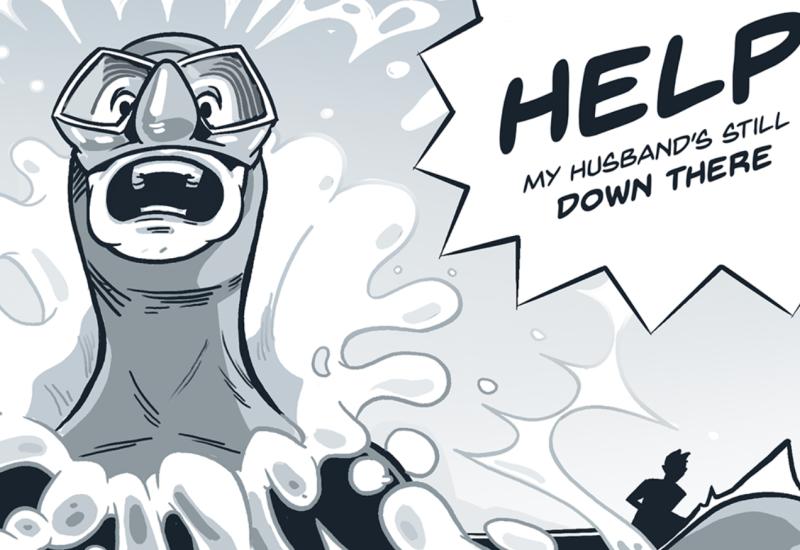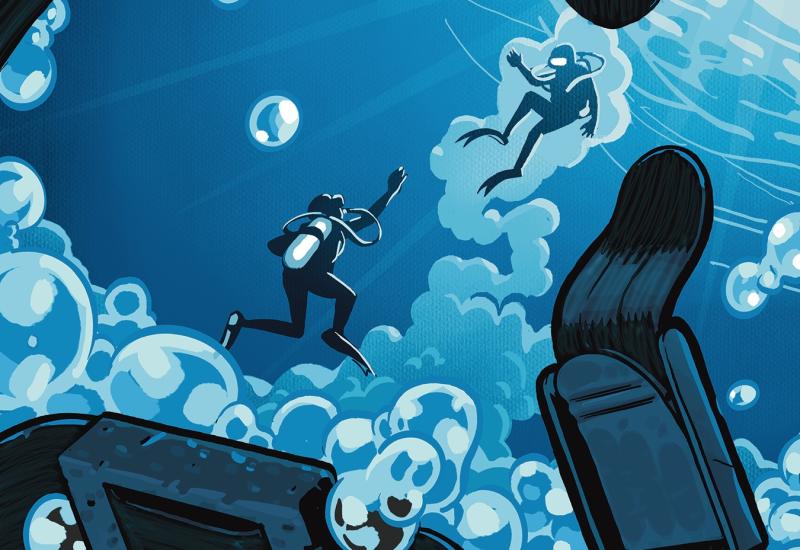Trouble at the Surface
April 2000
Setting the Stage
Ed.'s note: The incidents described here are real. Names of locations and people have been changed or deleted.
A middle-aged couple, Joe and Margaret Kirby, had recently been certified along with their teenage daughter, Becky. The family had made a few resort dives before signing up for their first really independent boat trip closer to home. The dive operator offered a dive guide for the day as the three were still novices, but they declined.
The day was beautiful with rolling waves, clear skies and a moderate breeze. Complete briefings were conducted at the dock and on arrival at the dive site. The dive area was popular, and several dive boats had already arrived and taken the available mooring buoys. The boat carrying Joe, Margaret and Becky anchored beside the reef in a sandy area. All of the dive boats there that day had student divers on board and planned their dives within the skill level of these divers.
The Dive and Rescue
After the student divers had entered the water, the Kirbys did likewise and made a free descent to the 40- to 60-foot depth range and, using a compass course, proceeded along the coral reef.
At about 70 feet, Becky indicated she had some difficulty, so they all surfaced together. At the surface, they discovered that they were quite far from their own boat and that they had traveled opposite from their intended direction, but were near another boat that was on a mooring. They signaled back to their boat, giving the OK signal and what appeared to be a "come get me" signal. The skipper, seeing the conflicting signals, sent the divemaster out to investigate, while he continued to bring the students on board.
The divemaster swam out, made contact with the three divers and inflated all of their BCs, while evaluating the situation and making sure everyone was breathing OK. The divemaster provided reassurance while they waited for their boat to pick them up. Suddenly, Margaret, who was using her regulator to breathe on the surface, said she was out of air. A quick check of her pressure gauge showed 1,100 psi. She then dropped her regulator second stage from her mouth. The divemaster replaced it, and she dropped it again. At this point, he gave the emergency signal and started in-water mouth-to-mouth resuscitation.
The nearby dive boat dropped its mooring and was beside the divers in two to three minutes. Margaret was brought aboard and full CPR was administered during the rushed trip back to the dock, but to no avail.
Accusations, Analysis and Consequences
In the legal action against the dive boat, skipper, divemaster and dive business, the family claimed that:
-
The conditions were unsafe, in particular that an extremely strong current of over three knots was running.
-
There was no dive briefing.
-
The divemaster did not swim out fast enough.
-
They should have used a chase boat, surfboard or float, pocket mask and an underwater recall.
Subsequent investigation revealed that:
-
NOAA had a continuously recording current meter on the reef at the site and depth of their dive, and, at the time of the accident, it recorded a variable current between zero and one-quarter of a knot.
-
Many student dives were made at the same time and place with no accidents or incidents. The procedures outlined in the briefings for divers who surface away from the boat indicated that divers should inflate their BCs, signal the boat and wait for pick-up. Of course, the boat would not put multiple students at risk by running the propellers while they were surfacing.
-
The divers did not follow the instructions to go down the anchor line and swim into the current; they incorrectly used their compass and went in the wrong direction.
-
When they first surfaced, Margaret was not having a problem. When she claimed she was out of air at 1,100 psi, it was a clear indication of stress, overbreathing or circulatory distress.
-
The whole family was using private-label, mail-order BCs and regulators.
-
The autopsy gave drowning as cause of death, due to a heart attack brought on by morbid obesity, coronary atherosclerosis and other medical problems.
-
The court dismissed the case based on the waiver and release form signed by the victim.
Lessons For Life
-
Be fit for diving, with particular emphasis on weight control in your middle years.
-
Follow the instructions of dive professionals.
-
Plan dives, and follow the plan, while allowing reasonable flexibility for unexpected opportunities or difficulties.
-
Know and use proper surface hand signals.
-
Buy quality dive gear.
-
Learn and use methods of underwater navigation, employing both natural aids and a compass.
-
If diving in a new environment or undertaking an unfamiliar dive activity, give serious consideration to the value of a professional guide.
April 2000
Setting the Stage
Ed.'s note: The incidents described here are real. Names of locations and people have been changed or deleted.
A middle-aged couple, Joe and Margaret Kirby, had recently been certified along with their teenage daughter, Becky. The family had made a few resort dives before signing up for their first really independent boat trip closer to home. The dive operator offered a dive guide for the day as the three were still novices, but they declined.
The day was beautiful with rolling waves, clear skies and a moderate breeze. Complete briefings were conducted at the dock and on arrival at the dive site. The dive area was popular, and several dive boats had already arrived and taken the available mooring buoys. The boat carrying Joe, Margaret and Becky anchored beside the reef in a sandy area. All of the dive boats there that day had student divers on board and planned their dives within the skill level of these divers.
The Dive and Rescue
After the student divers had entered the water, the Kirbys did likewise and made a free descent to the 40- to 60-foot depth range and, using a compass course, proceeded along the coral reef.
At about 70 feet, Becky indicated she had some difficulty, so they all surfaced together. At the surface, they discovered that they were quite far from their own boat and that they had traveled opposite from their intended direction, but were near another boat that was on a mooring. They signaled back to their boat, giving the OK signal and what appeared to be a "come get me" signal. The skipper, seeing the conflicting signals, sent the divemaster out to investigate, while he continued to bring the students on board.
The divemaster swam out, made contact with the three divers and inflated all of their BCs, while evaluating the situation and making sure everyone was breathing OK. The divemaster provided reassurance while they waited for their boat to pick them up. Suddenly, Margaret, who was using her regulator to breathe on the surface, said she was out of air. A quick check of her pressure gauge showed 1,100 psi. She then dropped her regulator second stage from her mouth. The divemaster replaced it, and she dropped it again. At this point, he gave the emergency signal and started in-water mouth-to-mouth resuscitation.
The nearby dive boat dropped its mooring and was beside the divers in two to three minutes. Margaret was brought aboard and full CPR was administered during the rushed trip back to the dock, but to no avail.
Accusations, Analysis and Consequences
In the legal action against the dive boat, skipper, divemaster and dive business, the family claimed that:
The conditions were unsafe, in particular that an extremely strong current of over three knots was running.
There was no dive briefing.
The divemaster did not swim out fast enough.
They should have used a chase boat, surfboard or float, pocket mask and an underwater recall.
Subsequent investigation revealed that:
NOAA had a continuously recording current meter on the reef at the site and depth of their dive, and, at the time of the accident, it recorded a variable current between zero and one-quarter of a knot.
Many student dives were made at the same time and place with no accidents or incidents. The procedures outlined in the briefings for divers who surface away from the boat indicated that divers should inflate their BCs, signal the boat and wait for pick-up. Of course, the boat would not put multiple students at risk by running the propellers while they were surfacing.
The divers did not follow the instructions to go down the anchor line and swim into the current; they incorrectly used their compass and went in the wrong direction.
When they first surfaced, Margaret was not having a problem. When she claimed she was out of air at 1,100 psi, it was a clear indication of stress, overbreathing or circulatory distress.
The whole family was using private-label, mail-order BCs and regulators.
The autopsy gave drowning as cause of death, due to a heart attack brought on by morbid obesity, coronary atherosclerosis and other medical problems.
The court dismissed the case based on the waiver and release form signed by the victim.
Lessons For Life
Be fit for diving, with particular emphasis on weight control in your middle years.
Follow the instructions of dive professionals.
Plan dives, and follow the plan, while allowing reasonable flexibility for unexpected opportunities or difficulties.
Know and use proper surface hand signals.
Buy quality dive gear.
Learn and use methods of underwater navigation, employing both natural aids and a compass.
If diving in a new environment or undertaking an unfamiliar dive activity, give serious consideration to the value of a professional guide.










